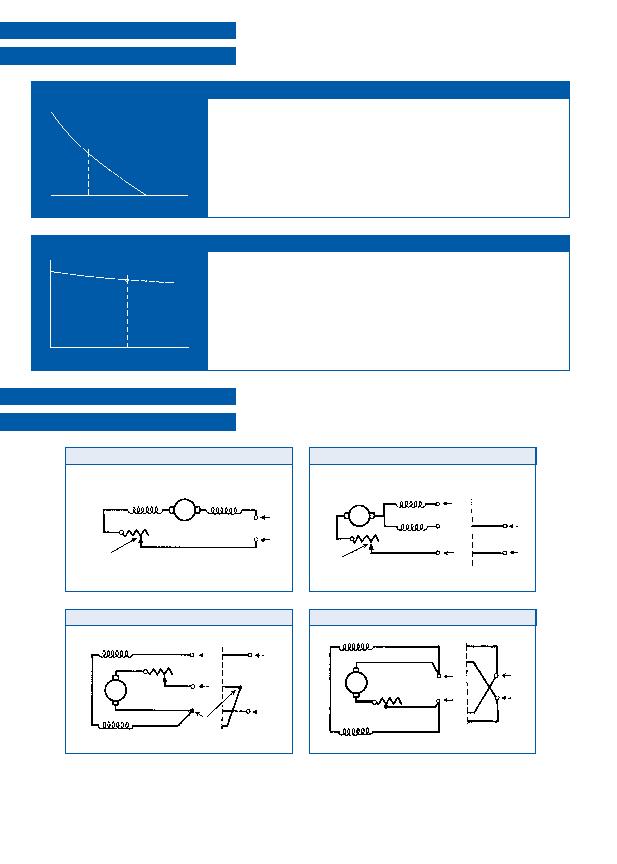
Series Wound 2 Lead
Series Wound 4 Lead Reversing
Series Wound 3 Lead Reversing (Split-Series)
D.C. Shunt Wound
Shown is a typical "torque/speed" characteristic for series wound motors. Series wound motors can be
wound for A.C. or D.C. supply. A.C. wound units when operated from a similar D.C. voltage will have
approximately 15% increase in output.
Suitable for reversing as standard i.e. 4 leads brought out (two armature and two field). Series motors can
be supplied as 3 lead reversing (split field) (the motor runs on one field coil at a time with approximately
30% power loss), change of direction being affected by a single pole switch.
As will be seen from the characteristic the speed varies inversely with the load, consequently series wound
motors should not be oversized for their particular application as this will result in the motor running at much
higher speeds than required.
It is possible to control the speed of this type of motor by means of a variable resistance transformer in a
ratio 5:1 although this can vary depending on the application.
ARMATURE
ARMA
TURE
Field
Field
Field
Field
White
White
White
Red
Red
White
If speed control required
insert rheostat thus
Join
and
insulate
Reverse
rotation
If speed control required
insert rheostat thus
Supply
Supply
ARMATURE
ARMA
TURE
Field
Field
Field
Field
White
White
Red
Red
Red
White
White
Reverse
rotation
Reverse
rotation
If speed control required
insert rheostat thus
Supply
Supply
Supply
Supply
Characteristics of Commutator
Motors
Connection Diagrams for Wound
Field Commutator Motors
Series Wound Motors
FULL LOAD
SPEED
TORQUE
Shown is a typical "torque/speed" characteristic for D.C. shunt wound motors. This type of unit has constant
speed characteristics, the difference between no load and full load speed being between 10% and 20% of
rated speed.
Suitable for reversing as standard i.e. 4 leads brought out (two armature and two fields). The speed can be
controlled by means of a variable resistance in series with the armature by a ratio of approximately 6:1,
however this can vary considerably depending on the application. Alternatively if an A.C. supply is
available a speed range of up to 25:1 can be obtained by means of a D.C. thyristor controller.
IMPORTANT: It must be noted, in mind when reducing the motor speed the armature cooling fan efficiency
drops and therefore it is wise to reduce the rating or load of the motor by 3040% over a speed range of
10:1 and by 50% for a speed range of 25:1.
Shunt Wound Motors
SPEED
FULL LOAD
TORQUE
14
11
13
12
If speed control required
insert rheostat thus
44
